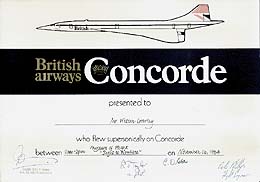On November 15, 1984, a British Airways Concorde supersonic airliner pays its first visit to Seattle. The slender delta-winged SST lands at Boeing Field bearing a cargo of just-bottled Beaujolais nouveau wine accompanied by Seattle restaurateur Mick McHugh and his guests. The following day, the plane carries passengers on a "Flight to Nowhere" over the Pacific Ocean as a fundraiser for the Museum of Flight. It departs Seattle-Tacoma International Airport on November 17, 1984. Nineteen years later the Concordes will be retired. One aircraft will return to Seattle on November 5, 2003, to join the permanent collection of the Museum of Flight.
Beaujolais Express
The Concorde was chartered to fly from London to Seattle by Mick McHugh as a promotion for his and partner Tim Firnstahl’s restaurants. The annual release of new-vintage George DuBoeuf Beaujolais wine is a major event in France, and it may not be uncorked before midnight on November 15. The restaurateurs arranged for the SST with the goal of speeding 219 cases of wine to Seattle for its first opening in the state, but they lost their supersonic dash to others who arranged a special advance shipment by more conventional means.
The “Flight to Nowhere” entailed a round trip from Boeing Field to a point about 2,000 miles west over the Pacific. The aircraft exceeded Mach 2 (twice the speed of sound) and reached an altitude of 50,000 feet -- high enough for passengers to observe the fading of the Earth’s atmosphere into outer space.
Although designed to serve a wealthy “jet set” market, the Concorde’s seating is quite cramped in a narrow, spartan cabin. The passenger windows are also very small due to the pressures and temperatures generated by high-speed travel.
Ironic Visitor
The Concorde was designed and built by a consortium of British and French aerospace companies in an international race to launch the first civilian supersonic transport. The first of 16 Concordes entered commercial service with British Airways and Air France in 1976, and they operated without mishap until an aircraft was lost with all aboard shortly after takeoff from Paris on July 25, 2000. The fleet was temporarily grounded during an investigation (which identified runway debris as the cause), but economics and declining traffic for the expensive transatlantic flights -- $9,000 round trip -- finally undid the Concordes in 2003.
The SST contest was actually won by the Soviet TU-144, which took its maiden flight on December 31, 1968. Two years later, Congress cancelled funding for a Boeing-built SST, which helped to trigger the “Boeing Bust” of the early 1970s. The Development Center created by Boeing for its SST stands within view of the Museum of Flight, where the Concorde came to rest at last.

